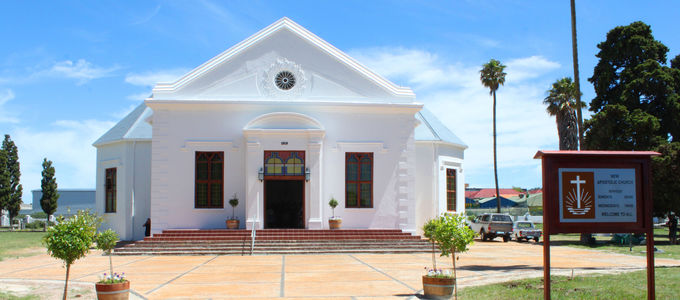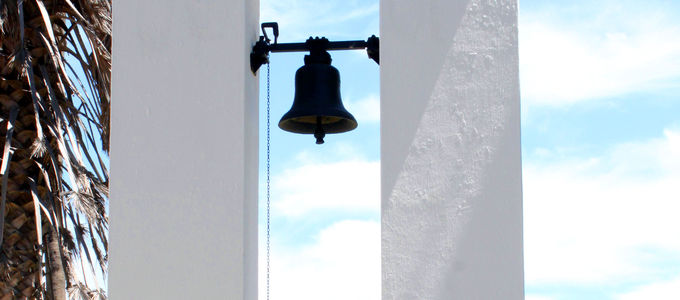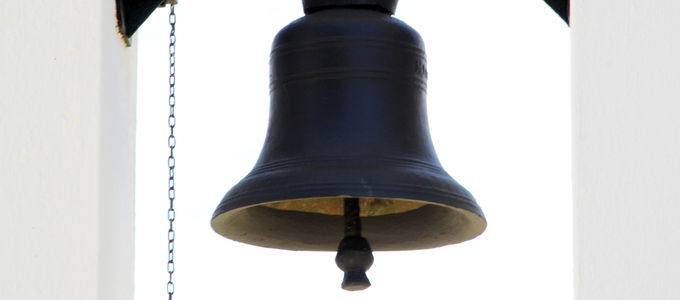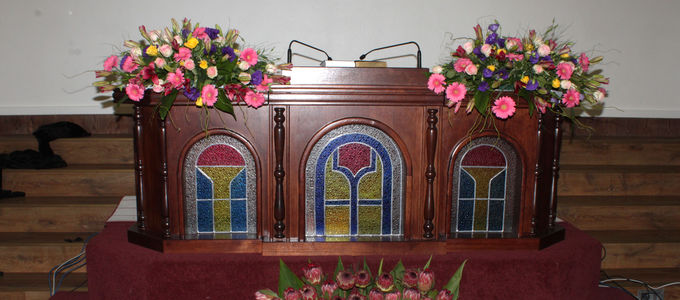
In 2014 the congregation in Somerset in Cape Town (South Africa) moved into a different place of worship. The congregation’s new home is an old Dutch Reformed Church that was taken over by the New Apostolic Church and renovated. The building is over 200 years old.
In 1817 some farmers asked their governor, Lord Charles Somerset, for permission to construct a church in the area of the mountain region of Helderberg and establish a village there. Their application was granted, and construction began in 1819. On 13 February 1820 the church building was officially dedicated.
In 1862 the structure was extensively renovated. However, the north gable collapsed on account of an unusually cold winter before the church could even be reopened. Fortunately it was possible to repair the damage before the building opened its doors to the congregation once again.
In the Second Boer War between 1899 and 1902, the journalist and politician Jan Hendrick Hofmeyr—also known as Onze Jan (our Jan)—fought for harmony between nations. When he died in 1909, he was buried in the cemetery of the Dutch Reformed Church in Somerset.
Cultural heritage site saved from ruin
After over one hundred years in use, the church building became too small for the congregation, and its members moved into a new building. Since the old building was now no longer in use, it gradually fell into disrepair. At the start of the 1960s it was restored and made available to the Dutch Reformed Missionary Church once again. Its members used the building until well into the 1990s, after which point it began to fall into disrepair again.
After a school was housed in the building for a while, it stood empty again for a few years and was damaged as a result. The proprietors then decided to convert the former church into office space. It was then that the New Apostolic Church submitted a purchase application to the authorities, and the parties agreed on a twenty-year lease arrangement.
The building with its own cemetery was declared a national heritage site in 1963 due to its remarkable architecture, and in the year 2000, it was rededicated as a provincial cultural heritage site. The construction department of the Church in South Africa was therefore quite happy that the renovation work saved the historic building from deterioration.
A large and growing congregation
The congregation that now occupies the Somerset building was established in 1925 through the missionary efforts of John Diedericks, who later became the congregation’s rector. The congregation’s first building, which was dedicated in the year 1931, quickly became too small. Various halls were rented for divine services in the course of the ensuing years, but the number of members simply kept on growing—as did their wish to have a church building of their own in which to celebrate divine services.
In 2012, District Apostle Noel Barnes, together with the Apostles and Bishops, enjoyed a tour of the historic region of Somerset West in the context of a conference. In the process, they also came upon the vacant Dutch Reformed Church. At the grave of Jan Hendrick Hofmeyr, the group decided to sing a hymn—and in so doing, they noticed that Onze Jan had been buried there 103 years earlier, to the day.
The renovation of the building took twelve months. Various elements were replaced, and others repaired without impacting the character of the protected heritage building. In addition, a security system now protects the church building from intruders.
On 19 January 2014, District Apostle Noel Barnes conducted a dedication service for the congregation of Somerset, together with all the Apostles and Bishops of the then Cape District, in the congregation’s “new” church building.
The congregation, which consists of nearly 500 members, is very happy to once again have an actual church building of its own as a place of worship. In 2015, the New Apostolic Christians there even had occasion to enjoy a visit from Chief Apostle Jean-Luc Schneider to their congregation.




















